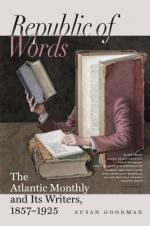The incidental associations of pictures link them to history, tradition, and human character, in a manner which indefinitely enhances their suggestiveness. Horace Walpole wove a standard collection of anecdotes from the lives and works of painters. The frescoes of St. Mark’s, at Florence, have a peculiar significance to the spectator familiar with Fra Angelico’s life. One of the most pathetic and beautiful tragedies in modern literature is that which a Danish poet elaborated from Correggio’s artist career. Lamb’s great treasure was a print from Da Vinci, which he called “My Beauty,” and its exhibition to a literal Scotchman gave rise to one of the richest jokes in Elia’s record. The pen-drawing Andre made of himself the night before his execution,—the curtain painted in the space where Faliero’s portrait should have been, in the ducal palace at Venice,—and the head of Dante, discovered by Mr. Kirkup, on the wall of the Bargello, at Florence,—convey impressions far beyond the mere lines and hues they exhibit; each is a drama, a destiny. And the hard but true lineaments of Holbein, the aerial grace of Malbone’s “Hours,” Albert Durer’s mediaeval sanctities, Overbeck’s conservative self-devotion, a market-place by Ostade, Reynolds’s “Strawberry Girl,” one of Copley’s colonial grandees in a New England farmer’s parlor, a cabinet gem by Greuze, a dog or sheep of Landseer’s, the misty depths of Turner’s “Carthage,” Domenichino’s “Sibyl,” Claude’s sunset, or Allston’s “Rosalie,”—how much of eras in Art, events in history, national tastes, and varieties of genius do they each foreshadow and embalm! Even when no special beauty or skill is manifest, the character of features transmitted by pictorial art, their antiquity or historical significance, often lends a mystery and meaning to the effigies of humanity. In the carved faces of old German church choirs and altars, the existent facial peculiarities of race are curiously evident; a Grecian life breathes from many a profile in the Elgin marbles, and a sacred marvel invests the exhumed giants of Nineveh; in the cartoons of Raphael, and the old Gobelin tapestries, are hints of what is essential in the progress and the triumphs of painting. Considered as a language, how definitely is the style of painters associated with special forms of character and spheres of life! It is this variety of human experience typified and illustrated on canvas, that forms our chief obligations




